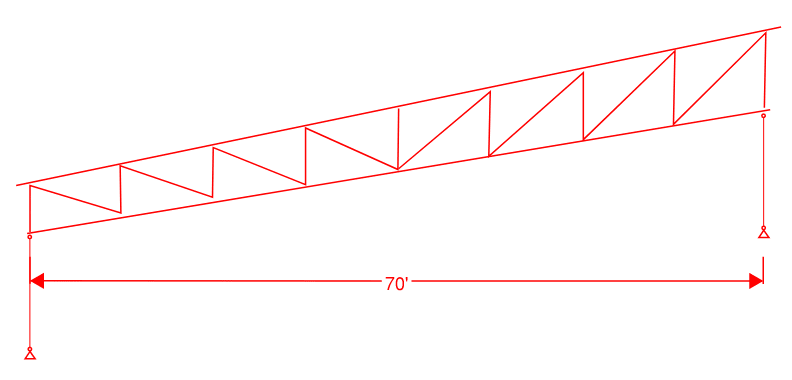mijowe
Structural
- Feb 3, 2003
- 204
I have a structure where a few of the common discussion on here are converging on each other and I wanted to get opinions on my approach.
• I have a long span (70’) mono sloped trusses with the top and bottom chords at different slopes. The trusses are bottom chord bearing and spaced at 7'-0" on center. The truss supplier is modeling them as pinned roller, I will be making a positive attachment at each support.
 .
.
• I have T&G deck topped with plywood to create a diaphragm. The trusses are exposed from below, so there is no ceiling diaphragm.
• The trusses are supported at each end by a wood wall. Because the of the slope the wall on the high end is a level up from the low end.
• Wind on the walls, ends of trusses, and suction on the top chord are producing the lateral loads on the system.
• The room is 126’ wide and I have shear walls at each end. My lateral load path is into the trusses, then the diaphragm and then the shear walls.
The load path for the lateral load on the walls is dubious to me, it needs to travel through the bottom chord then the webs and into the diaphragm.
Just looking for thoughts. Am I missing anything? Are there ways to add redundancy without adding too much additional cost?
• I have a long span (70’) mono sloped trusses with the top and bottom chords at different slopes. The trusses are bottom chord bearing and spaced at 7'-0" on center. The truss supplier is modeling them as pinned roller, I will be making a positive attachment at each support.

• I have T&G deck topped with plywood to create a diaphragm. The trusses are exposed from below, so there is no ceiling diaphragm.
• The trusses are supported at each end by a wood wall. Because the of the slope the wall on the high end is a level up from the low end.
• Wind on the walls, ends of trusses, and suction on the top chord are producing the lateral loads on the system.
• The room is 126’ wide and I have shear walls at each end. My lateral load path is into the trusses, then the diaphragm and then the shear walls.
The load path for the lateral load on the walls is dubious to me, it needs to travel through the bottom chord then the webs and into the diaphragm.
Just looking for thoughts. Am I missing anything? Are there ways to add redundancy without adding too much additional cost?
